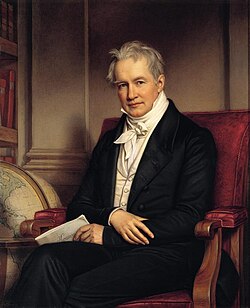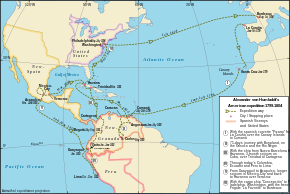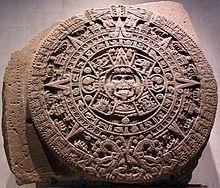Humboldt, Alexander von
Back
Basic data
-
Humboldt, Friedrich Wilhelm Heinrich Alexander von
-
September 14, 1769 in Berlin
-
†May 6, 1859 in Berlin
-
Naturforscher, Geograph, Geheimrat
-
Berlin
Documents
Biographical information from the WeGA
No biographical data found
Biography not available due to one of the following causes:
- Data will be added at a later stage
- Research of the WeGA was without success so far
- It is a well known person where enough information is available online elsewhere, see e.g Wikipedia







![Humboldt and Aimé Bonpland were in the Amazon rainforest by the Casiquiare River, with their scientific instruments, which enabled them to take many types of accurate measurements throughout their five-year journey. Oil painting by Eduard Ender, 1856. Humboldt did not like the painting as the instruments depicted were inaccurate.[53] (Source: Wikimedia) Humboldt and Aimé Bonpland were in the Amazon rainforest by the Casiquiare River, with their scientific instruments, which enabled them to take many types of accurate measurements throughout their five-year journey. Oil painting by Eduard Ender, 1856. Humboldt did not like the painting as the instruments depicted were inaccurate.[53] (Source: Wikimedia)](https://upload.wikimedia.org/wikipedia/commons/thumb/a/a1/Humboldt_and_Bonplant_in_the_Jungle.jpg/250px-Humboldt_and_Bonplant_in_the_Jungle.jpg)









![Humboldt's Naturgemälde, also known as the Chimborazo Map, is his depiction of the volcanoes Chimborazo and Cotopaxi in cross section, with detailed information about plant geography. The illustration was published in The Geography of Plants, 1807, in a large format (54 cm x 84 cm). Largely used for global warming analyses, this map depicts in fact the vegetation of another volcano: the Antisana.[103] (Source: Wikimedia) Humboldt's Naturgemälde, also known as the Chimborazo Map, is his depiction of the volcanoes Chimborazo and Cotopaxi in cross section, with detailed information about plant geography. The illustration was published in The Geography of Plants, 1807, in a large format (54 cm x 84 cm). Largely used for global warming analyses, this map depicts in fact the vegetation of another volcano: the Antisana.[103] (Source: Wikimedia)](https://upload.wikimedia.org/wikipedia/commons/thumb/7/7e/Zentralbibliothek_Z%C3%BCrich_-_Ideen_zu_einer_Geographie_der_Pflanzen_nebst_einem_Naturgem%C3%A4lde_der_Tropenl%C3%A4nder_-_000012142.jpg/250px-Zentralbibliothek_Z%C3%BCrich_-_Ideen_zu_einer_Geographie_der_Pflanzen_nebst_einem_Naturgem%C3%A4lde_der_Tropenl%C3%A4nder_-_000012142.jpg)


















